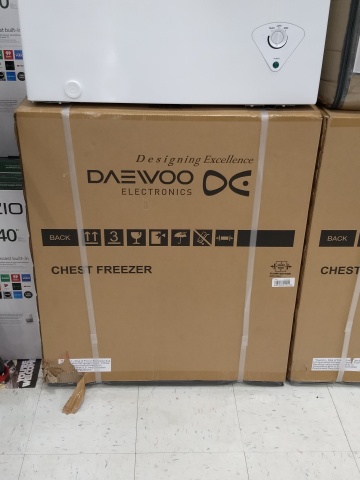Mark Dominus (陶敏修)
mjd@plover.com
I have another blog that doesn't suck.
Archive:
| 2023 | JF |
| 2022: | JFMAMJ |
| JASOND | |
| 2021: | JFM |
| 2020: | JFMAMJ |
| JASOND | |
| 2019: | JFMAMJ |
| JASOND | |
| 2018: | JFMAMJ |
| JASOND | |
| 2017: | ND |
Comments disabled

I complained recently about a miscast audiobook narrator. I mentioned I had preferred listening to Dr. Jekyll and Mr. Hyde, read by Sir Christopher Lee. But this is a pretty high bar. I am not so hard to please.
On the same trip, I also enjoyed listening to Frances Hodgson Burnett's The Secret Garden (1911), read by Kara Shallenberg. I hadn't read this myself in about forty years, and although I had liked it, I also remembered it being somewhat overwrought. I was apprehensive about listening too it because I was afraid I might find it embarrassing. But it was fine, and M. Shallenberg was a large part of why. Her reading was straightforward and unaffected. Many of the characters speak in Yorkshire dialect — this is a plot point — and here Ms. Shallenberg, who sounds like an American, had another opportunity to mess things up terribly, but didn't. I would be delighted to hear M. Shallenberg read Ancillary Justice. Thumbs up!
I also listened to a big chunk of The Scarlet Pimpernel, read by Karen Savage. Ms. Savage has a pleasant voice and a British accent. She is able to give the different characters different English and French accents, which sounded authentic to me. When she speaks French, it sounds to me like French, and not like someone who does not speak French trying to speak French. Maybe a British or French person would detect defects, but I didn't. Also thumbs up.
(Odd coincidence: I said that I thought the narrator of Ancillary Justice, Celeste Ciulla, would be a better fit for What Katy Did or Eight Cousins. Karen Savage has recorded both of these.)
Shortly after Katara was born, Lorrie's mother came from Seoul to visit us and help take care of the baby. She was also going to cook a large amount of Korean food and put it in the freezer for us to eat so we wouldn't have to cook as much. I was dispatched to H-mart store for ingredients, of course including garlic.
Nobody specified exactly how much garlic I should get, and knowing that my mother-in-law would be cooking a lot of Korean food, I bought five heads.
I will never forget the look of disdain that she gave to my five pitiful heads of garlic. “Never mind,” she said, in the tone of voice you would use for a small child who proudly informs you that they have cleaned up their own finger-painting. “I'll do it.”
First, and most obviously: five heads was not nearly enough.
But even more important, if you are a Korean mother-in-law and you are going to make a lot of food at once, you don't buy garlic by the head. You don't have time to peel a lot of garlic. Instead you buy a plastic jar that contains two kilograms of whole peeled cloves.
Oh well, lesson learned.
I saw this in the local supermarket. Daewoo has really misjudged the market. What good is a chest freezer? Who the hell needs their chest frozen?
Now if was a head freezer, or even just a brain freezer, I might consider buying one.
A few weeks ago my wife and kids were off at a conference so I took a road trip to Indianapolis and back via Kentucky and West Virginia. I hope to write up a report later on. Meantime I periodically had Google take down my passing thoughts, which I reproduce for you here with minimal explanation:
Don't forget to write an article about all the senses and the octopus sensorium
There is quite a lot to say.
There's a town in Pennsylvania named 84
I found this out because I saw directions to it on a highway sign. Had I known about this ahead of time, I might have scheduled a visit. Or maybe even a different road trip than the one I did take, something more like this:
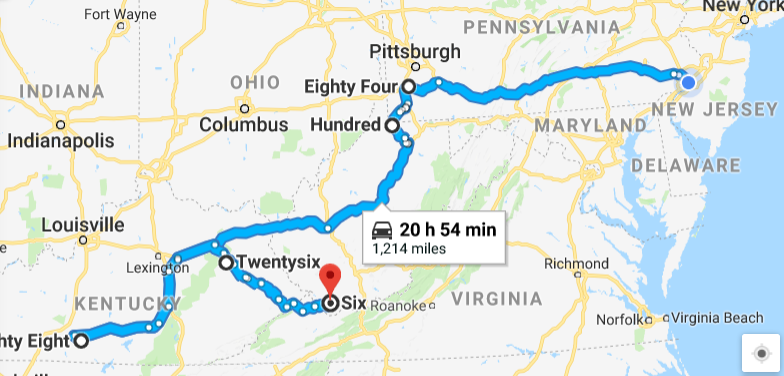
In related number news, I was astounded to find myself offered the chance to drive on Interstate 99. When I first saw the sign I couldn't quite believe it and wondered momentarily if I had wandered into an alternate universe. I was so surprised that I pulled the car over to take a picture of this marvel:
(Explanation for foreigners: in the U.S. Interstate Highway system, odd-numbered roads always run north and south, with the low numbers such as Interstate 5 farthest west, and numbers increasing as you go east. The eastmost such highway is the mighty Interstate 95, one of the oldest and busiest highways in the U.S.. It runs roughly up the entire east coast of the country for 3000 kilometers, from Miami in the south through or near most of the major northeastern cities including Washington, Baltimore, Wilmington, Philadelphia, New York, Providence, and Boston. As a lifelong inhabitant of the northeast, I was quite familiar with it. And of course there is no I-99 because that would be farther east than I-95, and therefore in or under the Atlantic Ocean.)
(And yet there it was, sitting obstinately in central Pennsylvania for no clear reason.)
Anyway there is an I-99. Two in fact. Who knew?
Write an article about inventions that should have happened sooner and include the paraglider and silage
The silage is the really amazing one. Everyone agrees that it was invented in the 19th century, but there seems to be no reason why the Sumerians shouldn't have been making it.
Ridership post
I have no idea what this was.
Oh, I bet I know now. I think it was Google transcribing my command to “write a shitpost…” and then cutting me off before I could say what it should be about.
Maybe the next one will have a clue?
Post maybe, Mickey
Nope, I have no idea.
Park ranger in Yogi Bear cartoons the same as the agent in The Matrix
No point explaining this one, I just have to show you.
For years I wanted to do a mockup of a “Perl Charms” breakfast cereal box,
with colored marbits shaped like $, @, %, and *, and a
picture on the box of Larry Wall dressed like a cartoon leprechaun.
Alas, I'll probably never do it.
Write about Harrison Bergeron as new dad
Ugh, yes. When my kids were babies I thought glumly about George Bergeron all the time.
Don't forget to write a blog post about destructive interference and what happens when all the light cancels out using that video that shows that it all comes out of the apparatus backwards
This is about question 4 in this ancient post about electromagnetism. Some time back someone pointed me to a youtube video that explains the answer and it's pretty excellent.
One place to visit is the Corning Glass Factory and museum in Corning New York
Maybe next time. I have a list of places to visit and this is on it.
There is a restaurant in West Virginia called Tudor's Biscuit World
BISCUIT WORLD!
In West Virginia there is a Nitro Museum what is that
It turns out that it is the town museum of Nitro, West Virginia, so-named because it was the center for nitrocellulose manufacture during World War I. (Nitrocellulose replaced black powder in firearm ammunition around the turn of the century.)
It would be really funny if someone were to hack Google Maps so that, one time in a million, the voice directions would say “in about half an inch, turn onto a tiny blue road.”
Even after all these years, the implicational fragment of logic still has the ability to surprise me. Today I was surprised to observe that:
$$((a\to b)\to a) \to (a\to b) \to b$$
is a theorem of logic. It was no longer surprising after I thought about it: if !!a\to b!! implies !!a!!, then it also implies formula that is implied by !!a!!, but !!a\to b!! itself shows that !!b!! is one of those formulas.
(As a term of combinatory logic, this is simply !!S I!!, so I wonder how I never noticed before.)
did you know? the human body only uses 15% of it's bones at any given time. imagine what would happen if we had access to 50%, or even 80% of our bones
Is there a standard mathematical term for two lines which do not intersect, but whose directions are perpendicular, as in the illustration?
[ Note: the word is not “skew”, which applies to any two nonparallel nonintersecting lines, whether or not they are perpendicular. ]
Eigenventricles.
One of the weirder episodes in the Oz series is in The Patchwork Girl of Oz (1913):
The room was of dazzling brilliance and beauty, for it was lined throughout with an exquisite metal that resembled translucent frosted silver. The surface of this metal was highly ornamented in raised designs representing men, animals, flowers and trees, and from the metal itself was radiated the soft light which flooded the room. All the furniture was made of the same glorious metal, and Scraps asked what it was.
“That's radium,” answered the Chief. “We Horners spend all our time digging radium from the mines under this mountain, and we use it to decorate our homes and make them pretty and cosy. It is a medicine, too, and no one can ever be sick who lives near radium.”
Marie Curie, co-discoverer of radium, died in 1934 of chronic illnesses caused by her long exposure to radiation.
The previous article came out in the (randomly generated) newsgroup
rec.food.cooking.buck-buck-mcgraw and that makes me think that maybe
he would be the mascot of an eponymous chain of chicken restuarants.
(“Come in to Buck-Buck McGraw's for the best fried chicken in the
tri-state area! Kids eat free on Tuesdays!”)
How is it possible that there isn't a famous cartoon chicken named Buck McGraw?
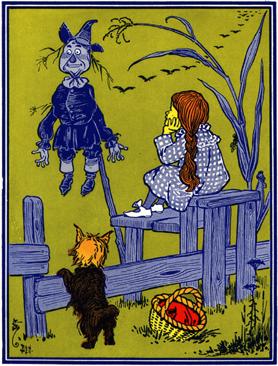
My early conference talk slides were unrelievedly dull, just lists of bullet points. After I got better at doing talks, I started adding diagrams and illustrations, then sometimes whimsical jokes or sarcastic comments in the form of illustrations. For example, once, on a slide discussing a blatantly false claim in a certain piece of API documentation, I included, without comment, a picture of Richard Nixon. (If I had it to do over I would use Pinocchio.)
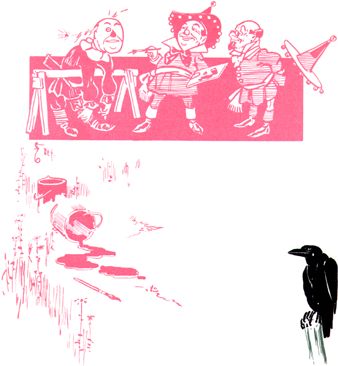
At some point I decided that it was almost always better to have some sort of picture of every slide, just to maintain visual interest. And if I thought about it I often came up with a suitable illustration, but not always. So one year I tried an experiment: have the slide-building software detect slides with no illustration, and automatically insert one at random into the margin.

As a committed Dadaist, I expected that this would produce delightful conjunctions of illustration and text, sometimes inane, sometimes perplexing, but every once in a while something amazing, hilarious, or profound that I would not have thought of on my own. The class was Tricks of the Wizards and I gathered W.W. Denslow's spot illustrations from the original 1900 edition of The Wonderful Wizard of Oz.

It didn't work. The random illustrations were just confusing. I never even bothered to test it on a live audience.
Here's one reason why I love Tim Gowers: he's really humble.

The standard presentation, above, demonstrates that the Petersen graph is nonplanar, since it obviously contracts to !!K_5!!.
To someone not versed in graph theory, this not only isn't obvious, it's unintelligible. In fact, it's indistinguishable from a meaningless parody:
The Cosell configuration, shown above, is semispatulated, since it obviously extends to a !!\zeta!!-complete net.
The amusing web site arXiv vs. snarXiv demonstrates this beautifully. It presents you with titles of two physics papers, one real, and one generated at random, and invites you to guess which is the real one.
I got six out of 10 correct, partly by luck. As it says, this is better than a monkey. Or at least a less-lucky monkey.
How about Occam's Weasel?
We leave recyclables for collection on the street in a place near the entrance to the home of neighbor A. Neighbor A has been complaining for some time about an unknown person who leaves bags of recyclables outside her door, because the collectors will not take bagged materials, only materials in bins. Then A has to deal with the bags herself.
Today while picking up my bin I noticed this had happened again. The collectors had come but had left behind a bag of bottles and cans and a second bag of shredded finanical documents. I examined the shreds for a while and observed that they had belonged to neighbor B. Then I carried the bags back to B's house and left them at her door so that A would not have to deal with them.
I wonder if I should suggest to B that she should consider replacing her office shredder with a cross-cut model. But I cannot think of a tactful way to do this. “You should take greater care to keep snoopers like myself from reading your private documents” seems like the wrong thing to say. Perhaps the return of the shredded documents will give her a hint and I should say nothing.
Web blog website was extensively probed yesterday. This is a common occurrence, but this probe had some peculiar features.
All the probes came from the same address, 42.51.216.29.
The 3,300 probes were mostly against URLs like
/admin/index/phpand/admin/index.aspx. Usually, attackers have a list of paths at which there have been past security holes. This attacker seems to be hoping to discover something new. (Every one of them was 404.)There were a number of requests for random-sounding pages ending in
.jpg, such as/tsnFile/UserFiles/Image/diaosi.asp/bdddf17533.jpg. If this was intended to disguise the activity, it wasn't doing a very good job. A bug?The referring-url was
http://www.nmily.com//Ac2.asp;.jpg. Generated at random perhaps? Some of the probed URLs were things like/Ac2.asp;.jpgand/sjurj54220.asp;.jpg.The claimed user agent was
Mozilla/5.0 (compatible; Baiduspider/2.0; +http://www.baidu.com/search/spider.htmlFollowed by the bytes 0xA3 0xA9.
When I did a reverse DNS lookup on the client address, I got the nonsense hostname
idc.ly.ha. There is no such domain.ha.HAis not even a valid ISO 3166 country code.When I did a traceroute, I saw what was going on with
idc.ly.ha:11 219.158.101.222 (219.158.101.222) 271.170 ms pc146.zz.ha.cn (61.168.250.146) 229.898 ms 219.158.101.222 (219.158.101.222) 271.159 ms 12 hn.kd.ny.adsl (182.118.124.66) 233.331 ms pc130.zz.ha.cn (61.168.37.130) 287.333 ms 276.773 ms 13 pc146.zz.ha.cn (61.168.250.146) 273.772 ms htuidc.bgp.ip (103.22.188.98) 237.818 ms 238.415 ms 14 * * hn.kd.ny.adsl (182.118.124.66) 278.467 ms 15 htuidc.bgp.ip (103.22.188.98) 276.015 ms * 276.096 ms 16 * idc.ly.ha (42.51.216.29) 465.040 ms 419.584 msSomeone is running a bunch of hosts (botnet maybe?) and advertising PTR records with random hostnames. (There is actually a
.ha.cn, but I doubt it is really involved.) Or do the returning ICMP package have fake source addresses?
It's all pretty weird.
Gigazine has published an article that discusses my earlier article on how to explain infinity to kids. It is in Japanese. I have learned that my name, transliterated into katakana, is マーク・ジェイソン・ドミナス.
At first I was pleased to see that the article had been written by someone who appeared, at least from their name (Mikael Leppä) to be Finnish. But then I realized that no, that was just the picture credit on the illustration to got from Flickr. So disappointing! Probably the article was written by some Japanese person.
Unless I am mistaken the color blue is not mentioned in the New Testament. I don't know what significance this might hold, being mostly ignorant of hermeneutics, but perhaps there is some.
Blue appears many times in the Old Testament, mostly in connection with ephods, which I have already explained.
Today's blog post about what to say when a kid asks you “what is infinity?” reminds me of something that I have been angry about for years. My family once went to visit some old friends. During the visit, two of our hosts had the following exchange:
Seven-year-old-daughter: Why is the sky blue?
Mom: Because God wanted it to be blue.
Holy fucking cow, even stipulating that these nice folks' religion is literally true and that this answer is literally correct, it is a terrible answer because it answers nothing; they might as well say “shut up, kid, and don't ask questions.” Just saying “I don't know” is a thousand times better than this.
If you believe, as perhaps this mom did, that God is the almighty lord and creator of the universe and the most important subject of human attention, and that her answer is correct, then it is important to consider the immediately following question:
Why does God want it to be blue and not some other color?
Does God prefer blue? Is blue better? Is there a moral or theological reason why it should be blue? We know from the Bible that God's truth wasn't revealed all at once; there were later revelations. Maybe next week someone is going to realize that the blueness of the sky is really an important communication from God about something, and we should have been paying closer attention to it. (This is well-precedented; see for example Gen 9:13, Exo 10:22, Josh 10:13, the famous vision of Constantine.)
Or perhaps Mom is wrong and God doesn't want it to be blue! A standard explanation for certain features of the world is that they are the work of Satan and are contrary to God's wishes. Could the blue sky be one of these? Was the prelapsarian sky some other color? Should we be trying to correct this? And how can we be sure which it is? How could it be unimportant whether the blue sky is the work of God or Satan?
Supposing that the blue sky is part of God's plan, shouldn't we try to understand this as we do the rest of His plan? What alternative is there? Who could be so presumptuous as to say “The almighty lord and creator of the universe made the sky blue for no reason at all, it was an arbitrary choice” or “God's plan is all-important, but not this particular part, which is merely an unimportant detail.”
And one might go a step farther with the next question:
How does God arrange that thy sky is blue?
Did God command Sherwin Williams to deliver unto Him one hundred trillion gallons of sky-blue paint? No, of course not, I'm just being silly. The actual answer is surprisingly complex: God's plan includes Rayleigh scattering. Now we should ask, why does God want Rayleigh scattering?
Religion can be used for good or for ill. It can be used to further inquiry, or to terminate its own understanding. There are varieties of religious feeling that are thoughtful, and others that are lazy and thoughtless, and disdainful of even the questions that religion itself claims are supremely important. To make oneself more lazy and thoughtless than necessary is not piety. It is despising the gifts of the bountiful God, who giveth us all things richly to enjoy.
Here's how Twitter excerpted one of the illustrations from a recent blog article:
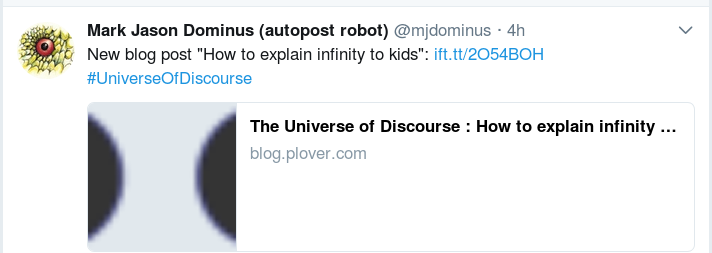
Here's the original illustration:


